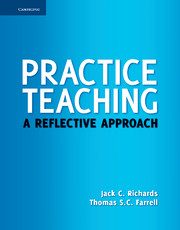Book contents
- Frontmatter
- Contents
- Introduction
- Chapter 1 Learning to Teach Through Practice Teaching
- Chapter 2 The Nature of Teacher Learning
- Chapter 3 Understanding the Teaching Context
- Chapter 4 Working With Your Cooperating Teacher
- Chapter 5 Planning Your Teaching
- Chapter 6 Teaching an Effective Language Lesson
- Chapter 7 Classroom Observation in Teaching Practice
- Chapter 8 Creating an Effective Classroom Learning Environment
- Chapter 9 Developing Learner-Centered Teaching
- Chapter 10 Classroom Discourse and Communication
- Chapter 11 Exploring Your Own Teaching
- Chapter 12 After Teaching Practice
- References
- Author Index
- Subject Index
Chapter 3 - Understanding the Teaching Context
Published online by Cambridge University Press: 05 October 2012
- Frontmatter
- Contents
- Introduction
- Chapter 1 Learning to Teach Through Practice Teaching
- Chapter 2 The Nature of Teacher Learning
- Chapter 3 Understanding the Teaching Context
- Chapter 4 Working With Your Cooperating Teacher
- Chapter 5 Planning Your Teaching
- Chapter 6 Teaching an Effective Language Lesson
- Chapter 7 Classroom Observation in Teaching Practice
- Chapter 8 Creating an Effective Classroom Learning Environment
- Chapter 9 Developing Learner-Centered Teaching
- Chapter 10 Classroom Discourse and Communication
- Chapter 11 Exploring Your Own Teaching
- Chapter 12 After Teaching Practice
- References
- Author Index
- Subject Index
Summary
INTRODUCTION
Teaching practice may take place in one or several very different contexts. For example, you might be teaching in a campus-based ESL program, in a local public school, in a community college, or a private language institute. Depending on the context, the learners you teach may be children, teenagers, or adults and may represent a variety of different social, economic, cultural, and educational backgrounds. Different teaching contexts present different notions of the process of learning to teach (Zeichner and Grant 1981). Campus-based teaching experiences (e.g., in a language center) may be quite different to those occurring in schools off campus. The students may be undergraduate international students rather than immigrants. The program may be supported with well-trained staff and superior support systems that do not always reflect conditions found in off-campus programs (Richards and Crookes 1988). Whatever the context in which you will be teaching, you will need to develop not only the skills of teaching but also the norms of practice expected of teachers in your school, both inside and outside the classroom. This will include understanding such things as the role of the prescribed curricula, the school culture, the routines of the classroom, and the school's procedures for lesson planning, as well as learning how to interact with students, school authorities, and colleagues.
In order to prepare for a successful practice-teaching experience, before you start your teaching practice you should therefore try to find out as much as possible about the school or institution where your teaching will take place, the kinds of language programs offered there, the kinds of teachers and students that you will work with, and what facilities and learning resources will be available.
- Type
- Chapter
- Information
- Practice TeachingA Reflective Approach, pp. 31 - 42Publisher: Cambridge University PressPrint publication year: 2011



